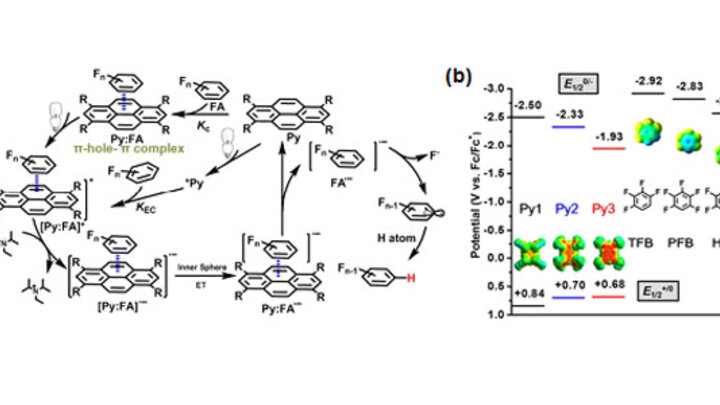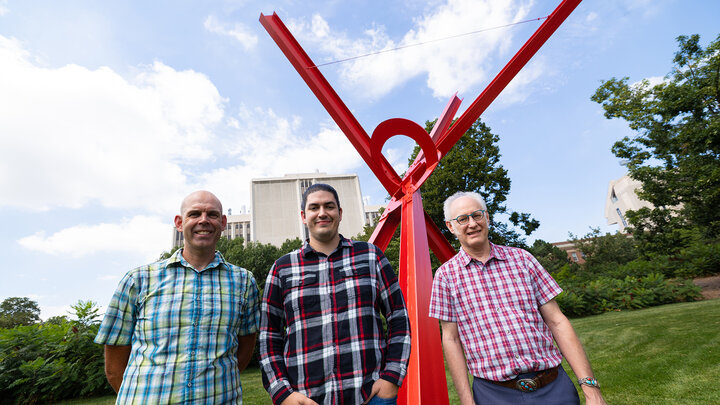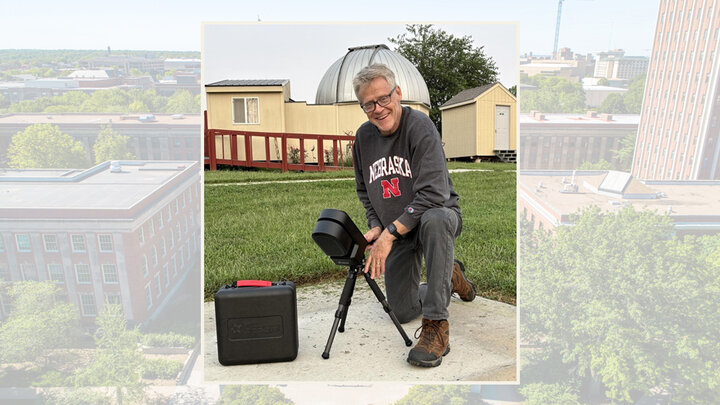Figure 1. (a) Proposed photocatalytic cycle for HDF. (b) Reduction potentials and density functional theory (DFT) computed electrostatic surface potential maps (inset) of Py and FA.
Electron transfer (ET) plays a critical role in many organic transformations.[1] In photoredox catalysis, the ET usually follows light-induced non-adiabatic outer-sphere ET mode, which requires suitable overpotential to achieve efficient ET kinetics.[2] Inner-sphere ET[3], on the other hand, can be achieved adiabatically between closely bind species, resulting in significantly faster ET than that predicted by the outer-sphere mode[4] due to strong electronic coupling. It can be envisioned that fast inner-sphere ET can be achieved when photocatalyst closely binds with substrate, which, however, has not been developed yet.
Polyfluoroarene–arene (also known as “π-hole[5]–π”) interaction is a directional and non-covalent intermolecular force, attributed to the weak electrostatic interaction between polyfluoroarenes (positive surface potential due to the flipped quadruple moment) and arenes (negative surface potential).[6] Dr. Zhang and co-workers discovered that light-induced efficient inner-sphere ET between FA and photocatalyst can be achieved when photocatalyst is an electron-rich arene (for example, Py), owing to the formation of “π-hole–π” complex between FA and photocatalyst (Figure 1a). More importantly, this process proceeds smoothly against a large underpotential (Figure 1a) and subsequently promotes a HDF reaction to yield partially fluorinated arenes (Figure 1b).
The formation of “π-hole–π” complexes were proved by 1H NMR titration and were further confirmed by DFT-based structure optimization. Furthermore, the stronger electrostatic interaction in “π-hole–π” complexes than the typical π–π stacking force was revealed by the average interplane distances in single crystal analysis. The team applied the optimized reaction condition to a series of FA and successfully access to the HDF products with good to excellent yield up to 93%. They also demonstrated the potential utility of Py in the metal-free C-F reductive alkylation. This work points to the further development of the design paradigm for photoredox catalysis where the size and shape of photocatalyst can be fine-tuned to enhance the overall catalytic activity. This work also constitutes a new example of the utility of weak, non-covalent interaction in small molecule catalysis.
This work was just accepted by JACS.[1] Houmam, A. Chem. Rev. 2008, 108, 2180
[2] Marcus, R. A. Angew. Chem. Int. Ed. 1993, 32, 1111
[3] Taube, H. Angew. Chem. Int. Ed. 1984, 23, 329
[4] Asahi, T.; Mataga, N. J. Phys. Chem. 1991, 95, 1956
[5] Bauza, A.; Mooibroek, T. J.; Frontera, A. ChemPhysChem 2015, 16, 2496
[6] Wang, H.; Wang, W.; Jin, W. J. Chem. Rev. 2016, 116, 5072




